HRM Project Report: Analyzing Human Resource Management at Sainsbury's
VerifiedAdded on 2023/01/19
|12
|3737
|42
Report
AI Summary
This report presents a comprehensive analysis of human resource management (HRM) practices, focusing on the case of Sainsbury's, a leading UK retail firm. The introduction highlights the importance of HRM in achieving competitive advantages and outlines the report's objectives, including describing the purpose and functions of HRM, evaluating recruitment and selection approaches, detailing the benefits of HRM practices for both employers and employees, and analyzing the significance of employee relations. Task 1 delves into the purpose and functions of HRM, differentiating between hard and soft HRM approaches, and discussing key functions like recruitment & selection, training and development, and motivation. The report then evaluates the strengths and weaknesses of internal and external recruitment sources and selection processes. The benefits of HRM practices for employers (increased productivity, better culture, and enhanced reputation) and employees (satisfying needs, enhancing performance, and motivation) are explored. Task 2 examines the importance of employee relations in influencing HRM decision-making, including its impact on productivity, job enlargement, absenteeism, and employee loyalty. The report also covers key elements of employee legislation and provides examples of applying HRM practices, such as training and development, career management, reward systems, and recruitment and selection. The conclusion summarizes the key findings and insights gained from the analysis, emphasizing the critical role of HRM in Sainsbury's success.
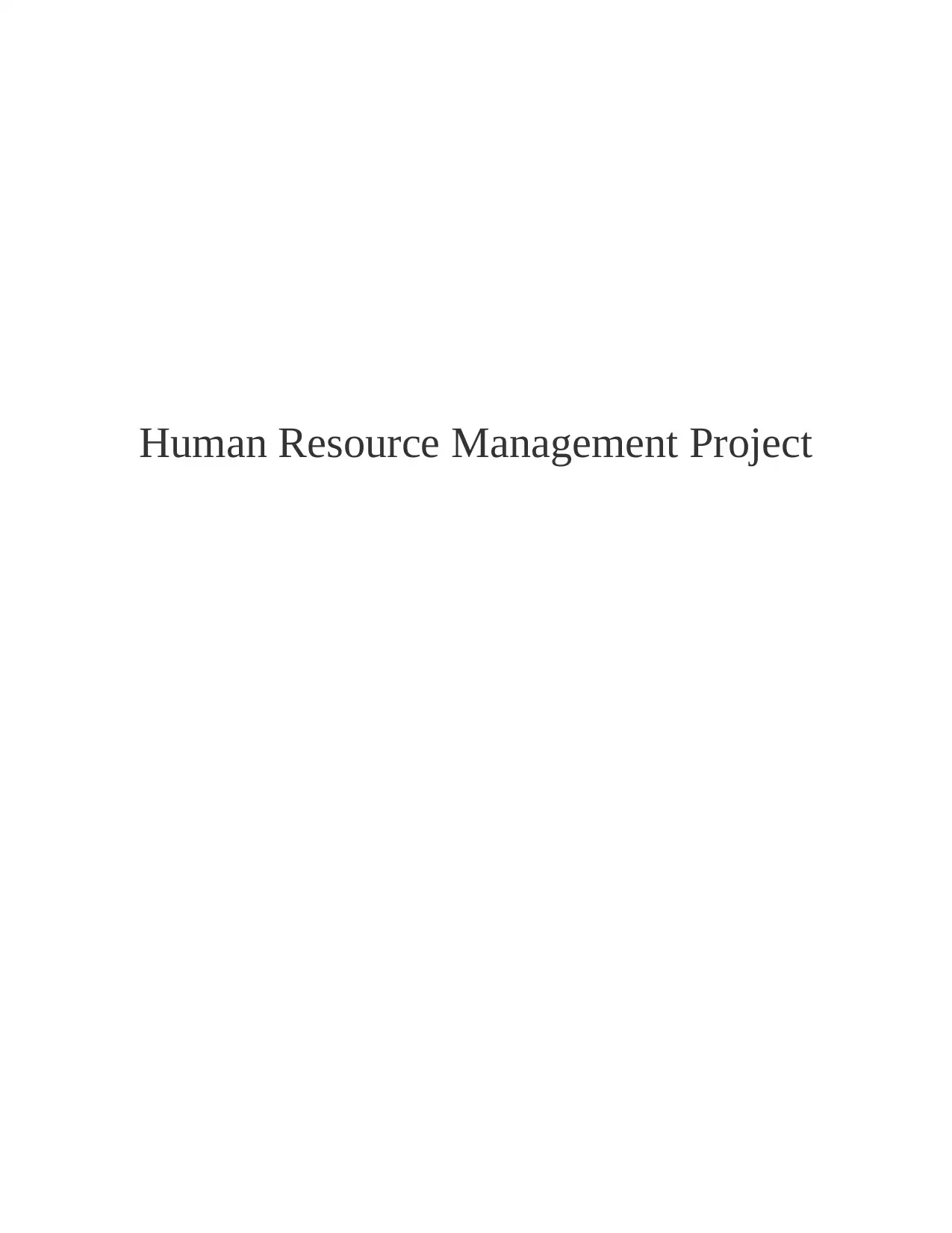
Human Resource Management Project
Paraphrase This Document
Need a fresh take? Get an instant paraphrase of this document with our AI Paraphraser
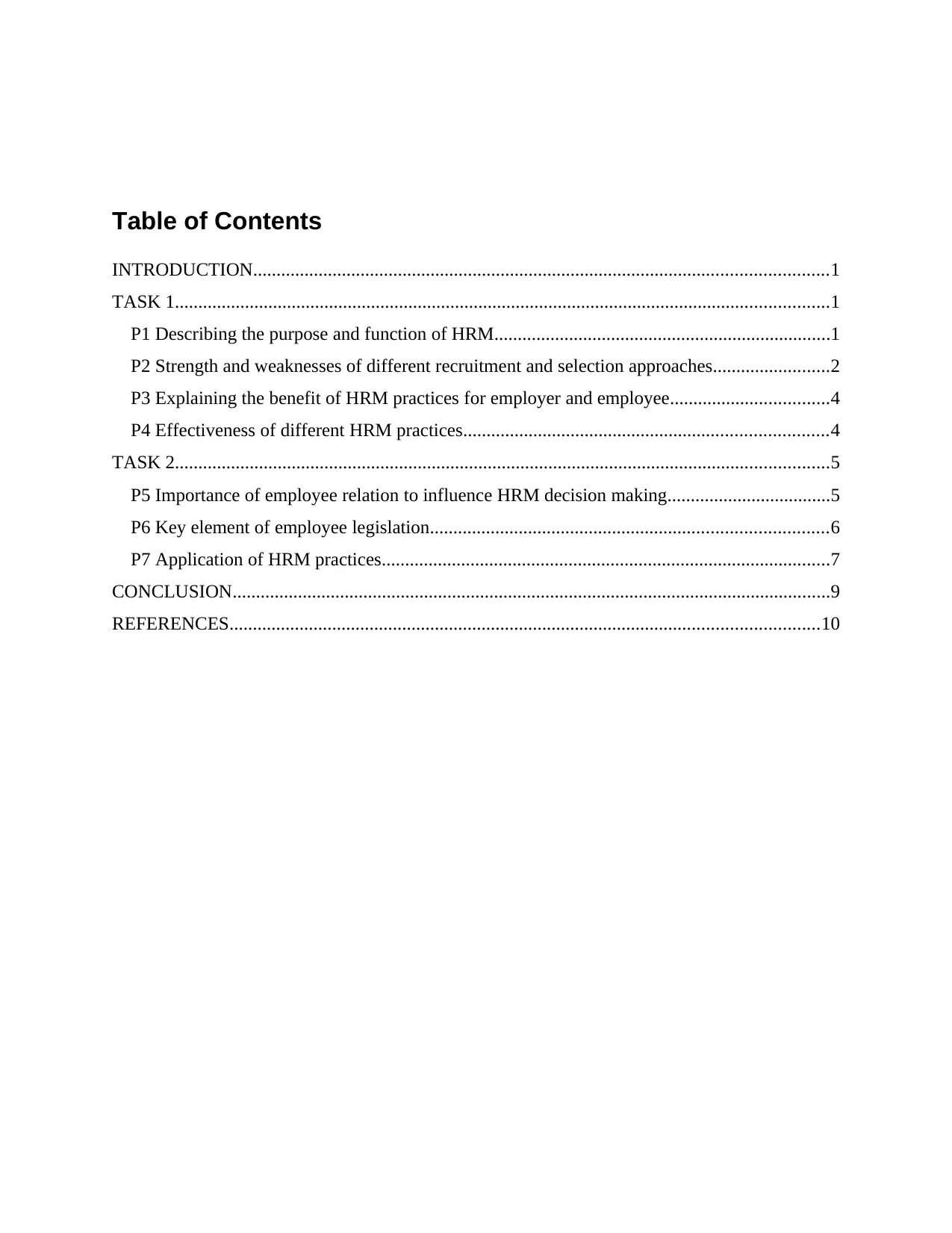
Table of Contents
INTRODUCTION...........................................................................................................................1
TASK 1............................................................................................................................................1
P1 Describing the purpose and function of HRM........................................................................1
P2 Strength and weaknesses of different recruitment and selection approaches.........................2
P3 Explaining the benefit of HRM practices for employer and employee..................................4
P4 Effectiveness of different HRM practices..............................................................................4
TASK 2............................................................................................................................................5
P5 Importance of employee relation to influence HRM decision making...................................5
P6 Key element of employee legislation.....................................................................................6
P7 Application of HRM practices................................................................................................7
CONCLUSION................................................................................................................................9
REFERENCES..............................................................................................................................10
INTRODUCTION...........................................................................................................................1
TASK 1............................................................................................................................................1
P1 Describing the purpose and function of HRM........................................................................1
P2 Strength and weaknesses of different recruitment and selection approaches.........................2
P3 Explaining the benefit of HRM practices for employer and employee..................................4
P4 Effectiveness of different HRM practices..............................................................................4
TASK 2............................................................................................................................................5
P5 Importance of employee relation to influence HRM decision making...................................5
P6 Key element of employee legislation.....................................................................................6
P7 Application of HRM practices................................................................................................7
CONCLUSION................................................................................................................................9
REFERENCES..............................................................................................................................10
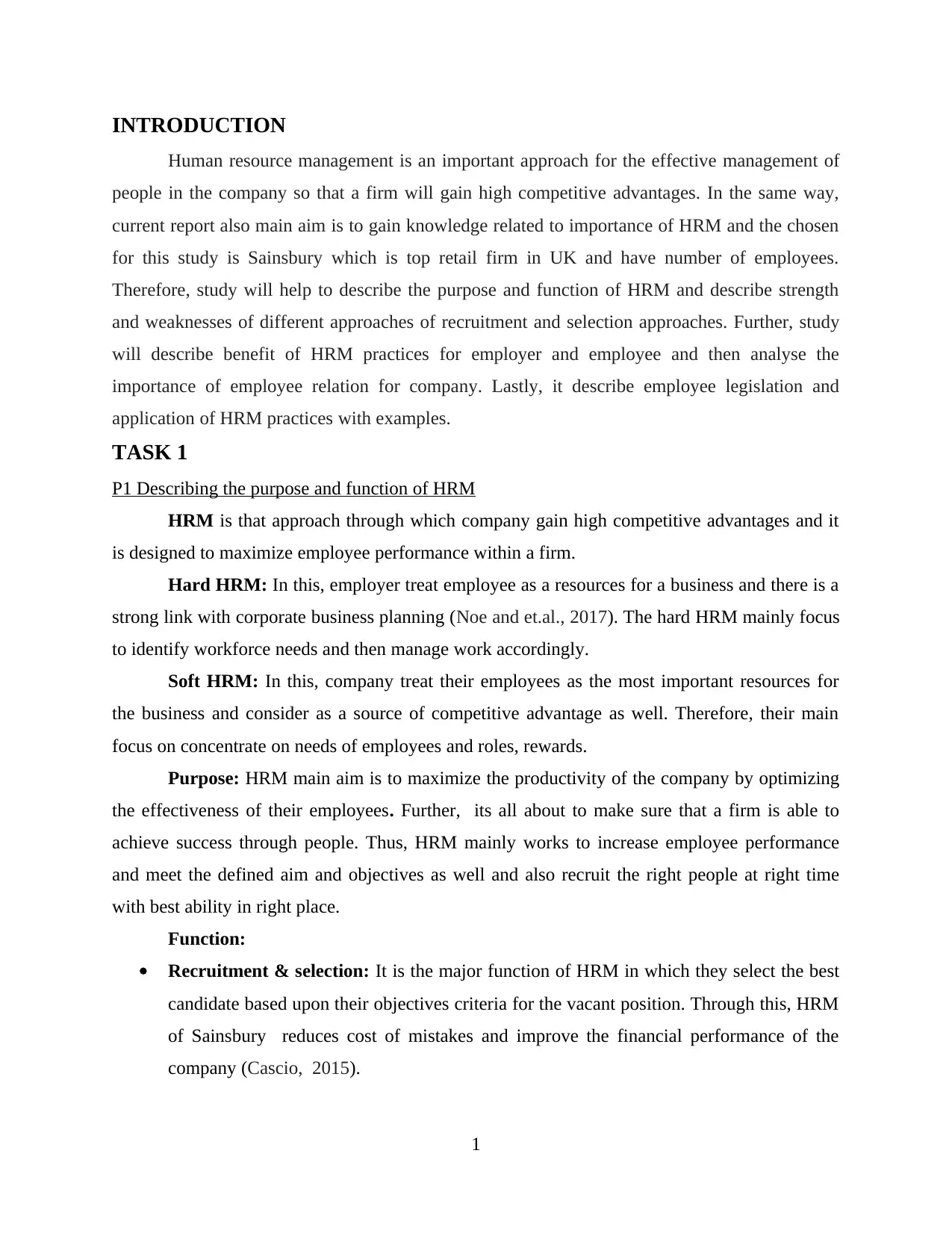
INTRODUCTION
Human resource management is an important approach for the effective management of
people in the company so that a firm will gain high competitive advantages. In the same way,
current report also main aim is to gain knowledge related to importance of HRM and the chosen
for this study is Sainsbury which is top retail firm in UK and have number of employees.
Therefore, study will help to describe the purpose and function of HRM and describe strength
and weaknesses of different approaches of recruitment and selection approaches. Further, study
will describe benefit of HRM practices for employer and employee and then analyse the
importance of employee relation for company. Lastly, it describe employee legislation and
application of HRM practices with examples.
TASK 1
P1 Describing the purpose and function of HRM
HRM is that approach through which company gain high competitive advantages and it
is designed to maximize employee performance within a firm.
Hard HRM: In this, employer treat employee as a resources for a business and there is a
strong link with corporate business planning (Noe and et.al., 2017). The hard HRM mainly focus
to identify workforce needs and then manage work accordingly.
Soft HRM: In this, company treat their employees as the most important resources for
the business and consider as a source of competitive advantage as well. Therefore, their main
focus on concentrate on needs of employees and roles, rewards.
Purpose: HRM main aim is to maximize the productivity of the company by optimizing
the effectiveness of their employees. Further, its all about to make sure that a firm is able to
achieve success through people. Thus, HRM mainly works to increase employee performance
and meet the defined aim and objectives as well and also recruit the right people at right time
with best ability in right place.
Function:
Recruitment & selection: It is the major function of HRM in which they select the best
candidate based upon their objectives criteria for the vacant position. Through this, HRM
of Sainsbury reduces cost of mistakes and improve the financial performance of the
company (Cascio, 2015).
1
Human resource management is an important approach for the effective management of
people in the company so that a firm will gain high competitive advantages. In the same way,
current report also main aim is to gain knowledge related to importance of HRM and the chosen
for this study is Sainsbury which is top retail firm in UK and have number of employees.
Therefore, study will help to describe the purpose and function of HRM and describe strength
and weaknesses of different approaches of recruitment and selection approaches. Further, study
will describe benefit of HRM practices for employer and employee and then analyse the
importance of employee relation for company. Lastly, it describe employee legislation and
application of HRM practices with examples.
TASK 1
P1 Describing the purpose and function of HRM
HRM is that approach through which company gain high competitive advantages and it
is designed to maximize employee performance within a firm.
Hard HRM: In this, employer treat employee as a resources for a business and there is a
strong link with corporate business planning (Noe and et.al., 2017). The hard HRM mainly focus
to identify workforce needs and then manage work accordingly.
Soft HRM: In this, company treat their employees as the most important resources for
the business and consider as a source of competitive advantage as well. Therefore, their main
focus on concentrate on needs of employees and roles, rewards.
Purpose: HRM main aim is to maximize the productivity of the company by optimizing
the effectiveness of their employees. Further, its all about to make sure that a firm is able to
achieve success through people. Thus, HRM mainly works to increase employee performance
and meet the defined aim and objectives as well and also recruit the right people at right time
with best ability in right place.
Function:
Recruitment & selection: It is the major function of HRM in which they select the best
candidate based upon their objectives criteria for the vacant position. Through this, HRM
of Sainsbury reduces cost of mistakes and improve the financial performance of the
company (Cascio, 2015).
1
⊘ This is a preview!⊘
Do you want full access?
Subscribe today to unlock all pages.

Trusted by 1+ million students worldwide
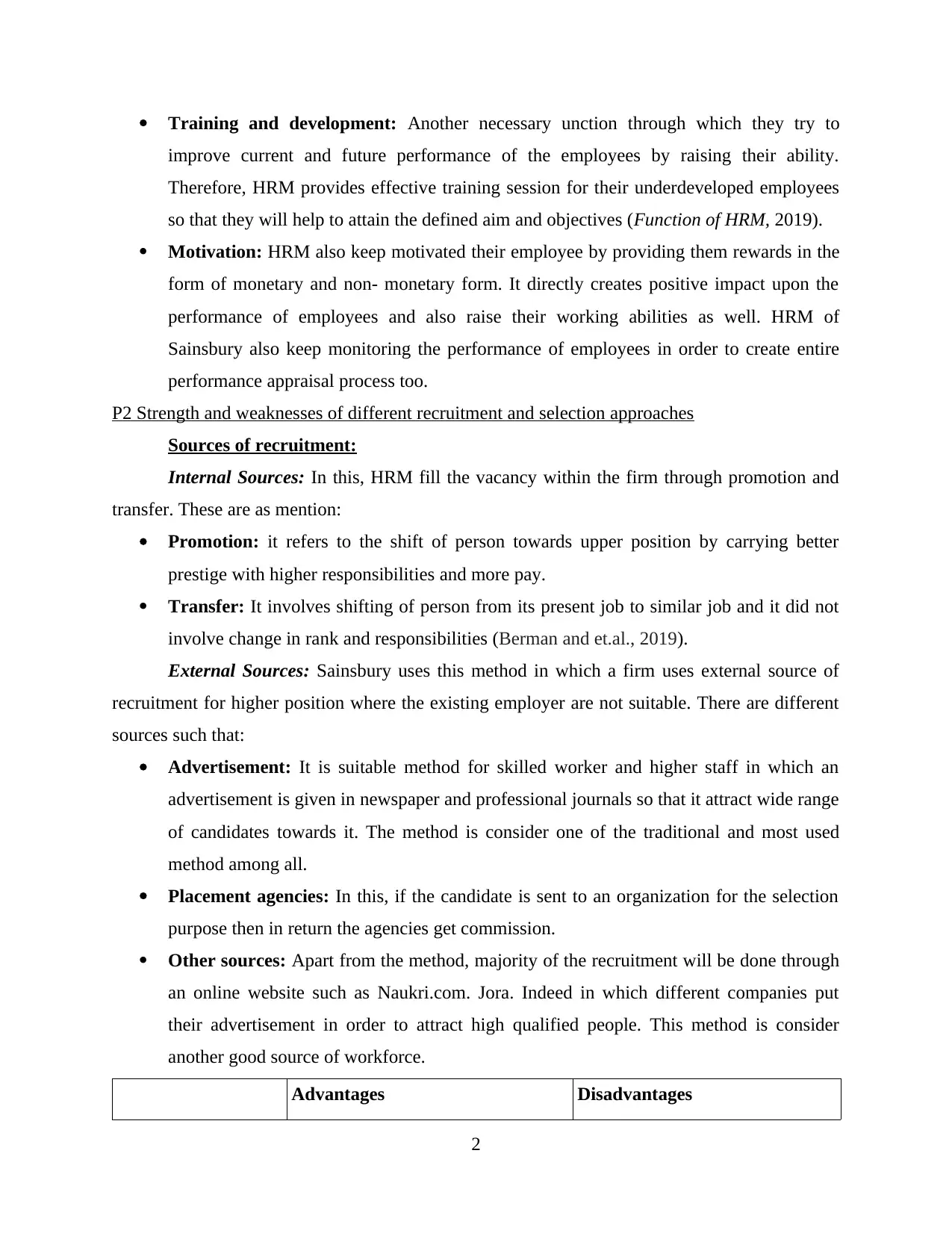
Training and development: Another necessary unction through which they try to
improve current and future performance of the employees by raising their ability.
Therefore, HRM provides effective training session for their underdeveloped employees
so that they will help to attain the defined aim and objectives (Function of HRM, 2019).
Motivation: HRM also keep motivated their employee by providing them rewards in the
form of monetary and non- monetary form. It directly creates positive impact upon the
performance of employees and also raise their working abilities as well. HRM of
Sainsbury also keep monitoring the performance of employees in order to create entire
performance appraisal process too.
P2 Strength and weaknesses of different recruitment and selection approaches
Sources of recruitment:
Internal Sources: In this, HRM fill the vacancy within the firm through promotion and
transfer. These are as mention:
Promotion: it refers to the shift of person towards upper position by carrying better
prestige with higher responsibilities and more pay.
Transfer: It involves shifting of person from its present job to similar job and it did not
involve change in rank and responsibilities (Berman and et.al., 2019).
External Sources: Sainsbury uses this method in which a firm uses external source of
recruitment for higher position where the existing employer are not suitable. There are different
sources such that:
Advertisement: It is suitable method for skilled worker and higher staff in which an
advertisement is given in newspaper and professional journals so that it attract wide range
of candidates towards it. The method is consider one of the traditional and most used
method among all.
Placement agencies: In this, if the candidate is sent to an organization for the selection
purpose then in return the agencies get commission.
Other sources: Apart from the method, majority of the recruitment will be done through
an online website such as Naukri.com. Jora. Indeed in which different companies put
their advertisement in order to attract high qualified people. This method is consider
another good source of workforce.
Advantages Disadvantages
2
improve current and future performance of the employees by raising their ability.
Therefore, HRM provides effective training session for their underdeveloped employees
so that they will help to attain the defined aim and objectives (Function of HRM, 2019).
Motivation: HRM also keep motivated their employee by providing them rewards in the
form of monetary and non- monetary form. It directly creates positive impact upon the
performance of employees and also raise their working abilities as well. HRM of
Sainsbury also keep monitoring the performance of employees in order to create entire
performance appraisal process too.
P2 Strength and weaknesses of different recruitment and selection approaches
Sources of recruitment:
Internal Sources: In this, HRM fill the vacancy within the firm through promotion and
transfer. These are as mention:
Promotion: it refers to the shift of person towards upper position by carrying better
prestige with higher responsibilities and more pay.
Transfer: It involves shifting of person from its present job to similar job and it did not
involve change in rank and responsibilities (Berman and et.al., 2019).
External Sources: Sainsbury uses this method in which a firm uses external source of
recruitment for higher position where the existing employer are not suitable. There are different
sources such that:
Advertisement: It is suitable method for skilled worker and higher staff in which an
advertisement is given in newspaper and professional journals so that it attract wide range
of candidates towards it. The method is consider one of the traditional and most used
method among all.
Placement agencies: In this, if the candidate is sent to an organization for the selection
purpose then in return the agencies get commission.
Other sources: Apart from the method, majority of the recruitment will be done through
an online website such as Naukri.com. Jora. Indeed in which different companies put
their advertisement in order to attract high qualified people. This method is consider
another good source of workforce.
Advantages Disadvantages
2
Paraphrase This Document
Need a fresh take? Get an instant paraphrase of this document with our AI Paraphraser
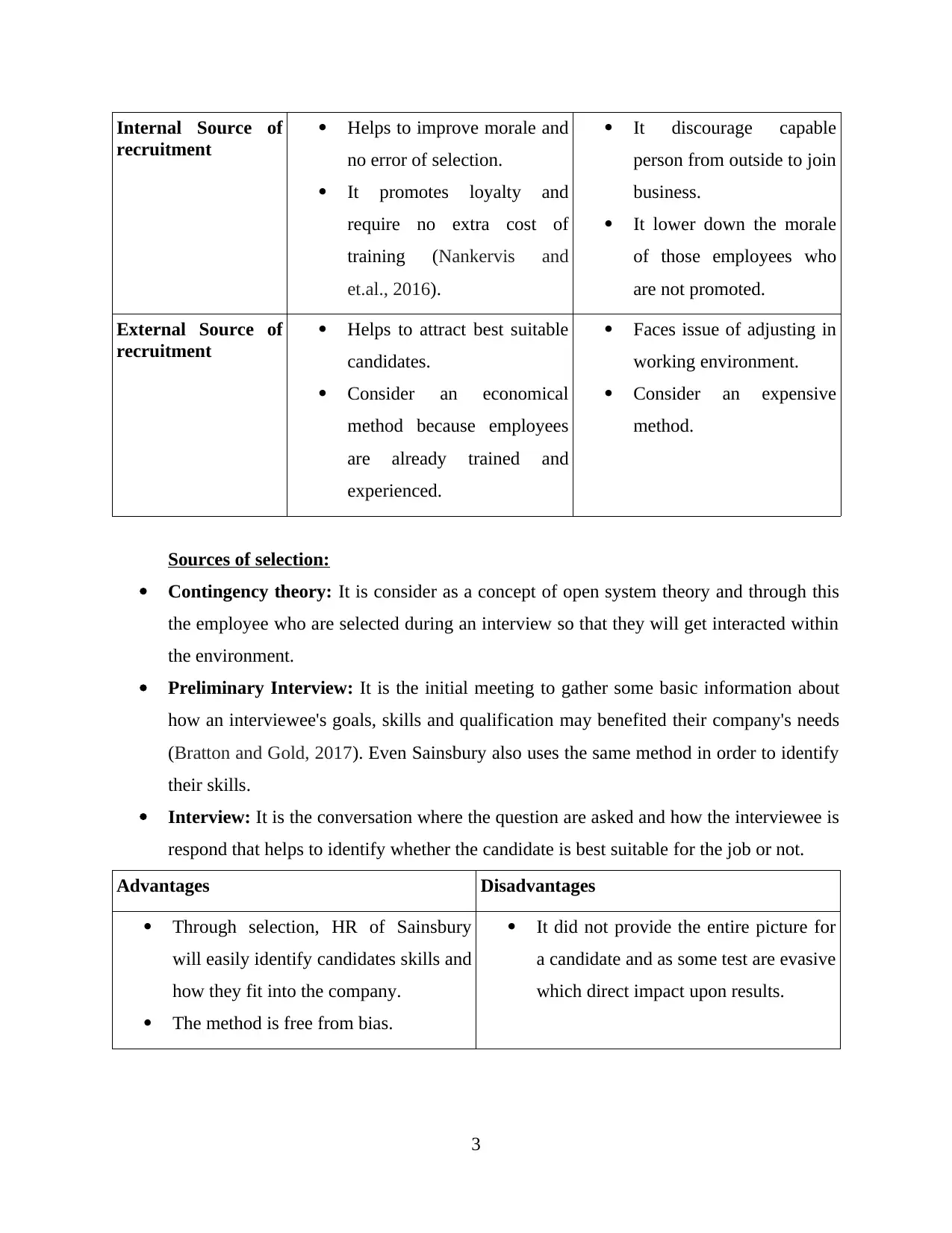
Internal Source of
recruitment
Helps to improve morale and
no error of selection.
It promotes loyalty and
require no extra cost of
training (Nankervis and
et.al., 2016).
It discourage capable
person from outside to join
business.
It lower down the morale
of those employees who
are not promoted.
External Source of
recruitment
Helps to attract best suitable
candidates.
Consider an economical
method because employees
are already trained and
experienced.
Faces issue of adjusting in
working environment.
Consider an expensive
method.
Sources of selection:
Contingency theory: It is consider as a concept of open system theory and through this
the employee who are selected during an interview so that they will get interacted within
the environment.
Preliminary Interview: It is the initial meeting to gather some basic information about
how an interviewee's goals, skills and qualification may benefited their company's needs
(Bratton and Gold, 2017). Even Sainsbury also uses the same method in order to identify
their skills.
Interview: It is the conversation where the question are asked and how the interviewee is
respond that helps to identify whether the candidate is best suitable for the job or not.
Advantages Disadvantages
Through selection, HR of Sainsbury
will easily identify candidates skills and
how they fit into the company.
The method is free from bias.
It did not provide the entire picture for
a candidate and as some test are evasive
which direct impact upon results.
3
recruitment
Helps to improve morale and
no error of selection.
It promotes loyalty and
require no extra cost of
training (Nankervis and
et.al., 2016).
It discourage capable
person from outside to join
business.
It lower down the morale
of those employees who
are not promoted.
External Source of
recruitment
Helps to attract best suitable
candidates.
Consider an economical
method because employees
are already trained and
experienced.
Faces issue of adjusting in
working environment.
Consider an expensive
method.
Sources of selection:
Contingency theory: It is consider as a concept of open system theory and through this
the employee who are selected during an interview so that they will get interacted within
the environment.
Preliminary Interview: It is the initial meeting to gather some basic information about
how an interviewee's goals, skills and qualification may benefited their company's needs
(Bratton and Gold, 2017). Even Sainsbury also uses the same method in order to identify
their skills.
Interview: It is the conversation where the question are asked and how the interviewee is
respond that helps to identify whether the candidate is best suitable for the job or not.
Advantages Disadvantages
Through selection, HR of Sainsbury
will easily identify candidates skills and
how they fit into the company.
The method is free from bias.
It did not provide the entire picture for
a candidate and as some test are evasive
which direct impact upon results.
3
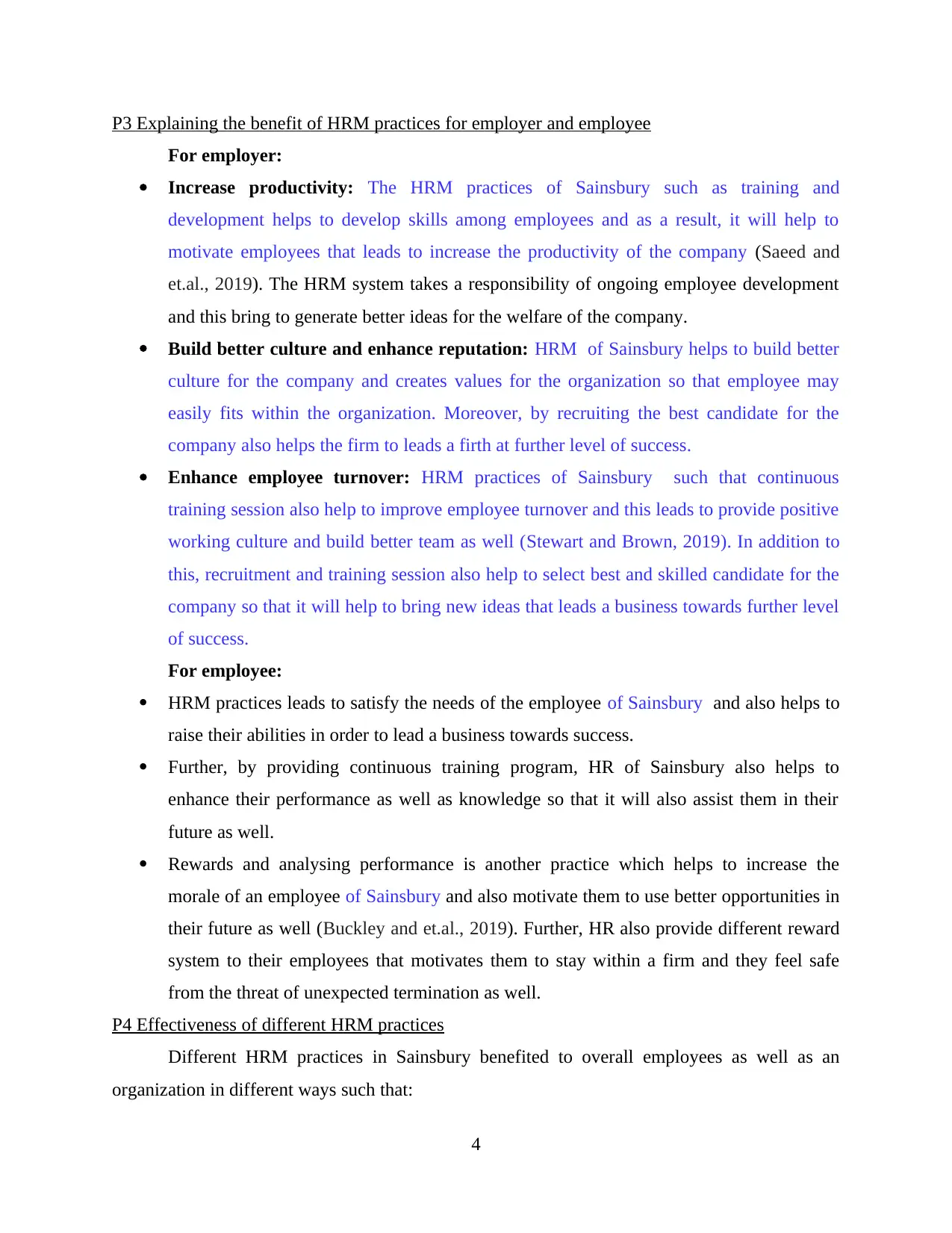
P3 Explaining the benefit of HRM practices for employer and employee
For employer:
Increase productivity: The HRM practices of Sainsbury such as training and
development helps to develop skills among employees and as a result, it will help to
motivate employees that leads to increase the productivity of the company (Saeed and
et.al., 2019). The HRM system takes a responsibility of ongoing employee development
and this bring to generate better ideas for the welfare of the company.
Build better culture and enhance reputation: HRM of Sainsbury helps to build better
culture for the company and creates values for the organization so that employee may
easily fits within the organization. Moreover, by recruiting the best candidate for the
company also helps the firm to leads a firth at further level of success.
Enhance employee turnover: HRM practices of Sainsbury such that continuous
training session also help to improve employee turnover and this leads to provide positive
working culture and build better team as well (Stewart and Brown, 2019). In addition to
this, recruitment and training session also help to select best and skilled candidate for the
company so that it will help to bring new ideas that leads a business towards further level
of success.
For employee:
HRM practices leads to satisfy the needs of the employee of Sainsbury and also helps to
raise their abilities in order to lead a business towards success.
Further, by providing continuous training program, HR of Sainsbury also helps to
enhance their performance as well as knowledge so that it will also assist them in their
future as well.
Rewards and analysing performance is another practice which helps to increase the
morale of an employee of Sainsbury and also motivate them to use better opportunities in
their future as well (Buckley and et.al., 2019). Further, HR also provide different reward
system to their employees that motivates them to stay within a firm and they feel safe
from the threat of unexpected termination as well.
P4 Effectiveness of different HRM practices
Different HRM practices in Sainsbury benefited to overall employees as well as an
organization in different ways such that:
4
For employer:
Increase productivity: The HRM practices of Sainsbury such as training and
development helps to develop skills among employees and as a result, it will help to
motivate employees that leads to increase the productivity of the company (Saeed and
et.al., 2019). The HRM system takes a responsibility of ongoing employee development
and this bring to generate better ideas for the welfare of the company.
Build better culture and enhance reputation: HRM of Sainsbury helps to build better
culture for the company and creates values for the organization so that employee may
easily fits within the organization. Moreover, by recruiting the best candidate for the
company also helps the firm to leads a firth at further level of success.
Enhance employee turnover: HRM practices of Sainsbury such that continuous
training session also help to improve employee turnover and this leads to provide positive
working culture and build better team as well (Stewart and Brown, 2019). In addition to
this, recruitment and training session also help to select best and skilled candidate for the
company so that it will help to bring new ideas that leads a business towards further level
of success.
For employee:
HRM practices leads to satisfy the needs of the employee of Sainsbury and also helps to
raise their abilities in order to lead a business towards success.
Further, by providing continuous training program, HR of Sainsbury also helps to
enhance their performance as well as knowledge so that it will also assist them in their
future as well.
Rewards and analysing performance is another practice which helps to increase the
morale of an employee of Sainsbury and also motivate them to use better opportunities in
their future as well (Buckley and et.al., 2019). Further, HR also provide different reward
system to their employees that motivates them to stay within a firm and they feel safe
from the threat of unexpected termination as well.
P4 Effectiveness of different HRM practices
Different HRM practices in Sainsbury benefited to overall employees as well as an
organization in different ways such that:
4
⊘ This is a preview!⊘
Do you want full access?
Subscribe today to unlock all pages.

Trusted by 1+ million students worldwide
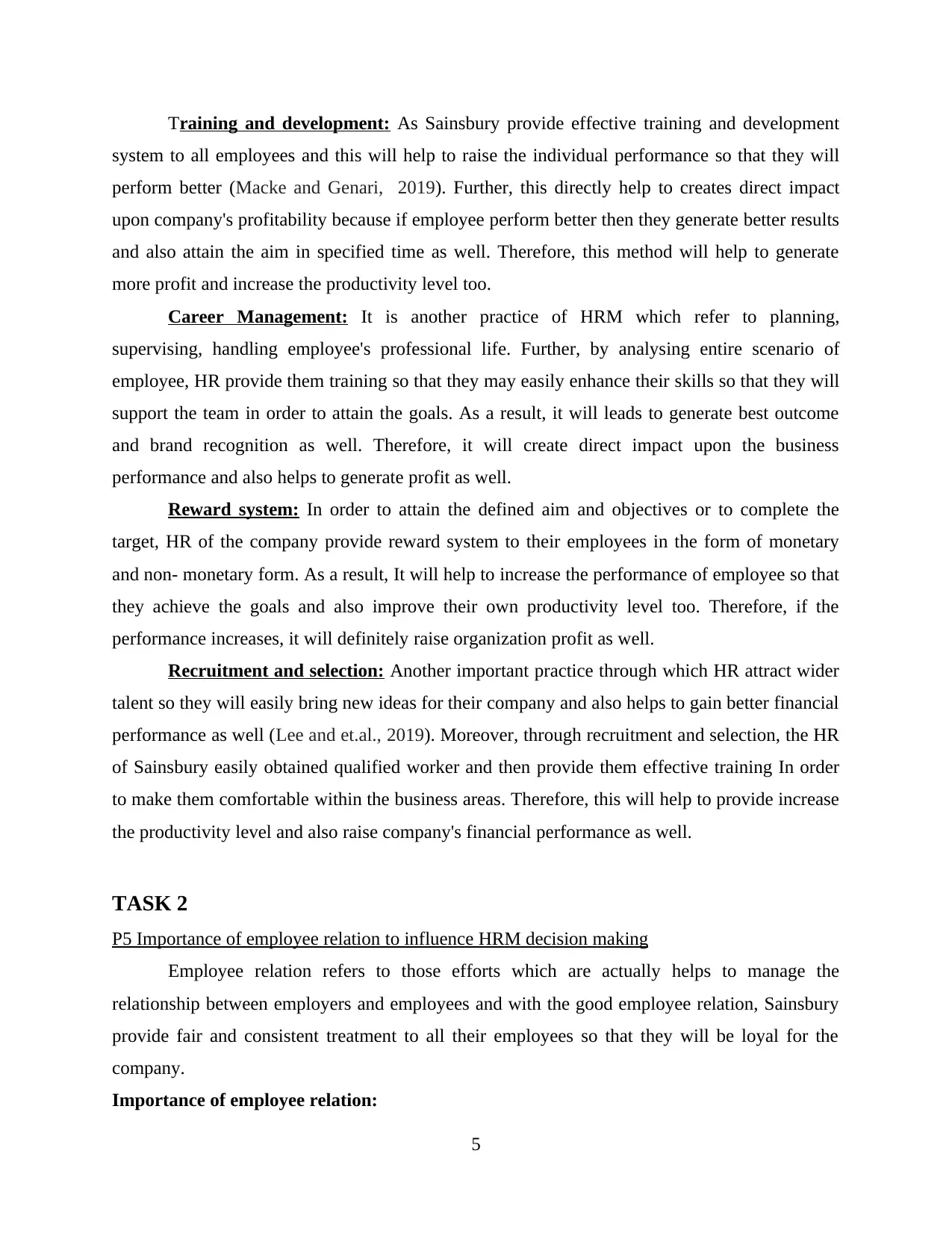
Training and development: As Sainsbury provide effective training and development
system to all employees and this will help to raise the individual performance so that they will
perform better (Macke and Genari, 2019). Further, this directly help to creates direct impact
upon company's profitability because if employee perform better then they generate better results
and also attain the aim in specified time as well. Therefore, this method will help to generate
more profit and increase the productivity level too.
Career Management: It is another practice of HRM which refer to planning,
supervising, handling employee's professional life. Further, by analysing entire scenario of
employee, HR provide them training so that they may easily enhance their skills so that they will
support the team in order to attain the goals. As a result, it will leads to generate best outcome
and brand recognition as well. Therefore, it will create direct impact upon the business
performance and also helps to generate profit as well.
Reward system: In order to attain the defined aim and objectives or to complete the
target, HR of the company provide reward system to their employees in the form of monetary
and non- monetary form. As a result, It will help to increase the performance of employee so that
they achieve the goals and also improve their own productivity level too. Therefore, if the
performance increases, it will definitely raise organization profit as well.
Recruitment and selection: Another important practice through which HR attract wider
talent so they will easily bring new ideas for their company and also helps to gain better financial
performance as well (Lee and et.al., 2019). Moreover, through recruitment and selection, the HR
of Sainsbury easily obtained qualified worker and then provide them effective training In order
to make them comfortable within the business areas. Therefore, this will help to provide increase
the productivity level and also raise company's financial performance as well.
TASK 2
P5 Importance of employee relation to influence HRM decision making
Employee relation refers to those efforts which are actually helps to manage the
relationship between employers and employees and with the good employee relation, Sainsbury
provide fair and consistent treatment to all their employees so that they will be loyal for the
company.
Importance of employee relation:
5
system to all employees and this will help to raise the individual performance so that they will
perform better (Macke and Genari, 2019). Further, this directly help to creates direct impact
upon company's profitability because if employee perform better then they generate better results
and also attain the aim in specified time as well. Therefore, this method will help to generate
more profit and increase the productivity level too.
Career Management: It is another practice of HRM which refer to planning,
supervising, handling employee's professional life. Further, by analysing entire scenario of
employee, HR provide them training so that they may easily enhance their skills so that they will
support the team in order to attain the goals. As a result, it will leads to generate best outcome
and brand recognition as well. Therefore, it will create direct impact upon the business
performance and also helps to generate profit as well.
Reward system: In order to attain the defined aim and objectives or to complete the
target, HR of the company provide reward system to their employees in the form of monetary
and non- monetary form. As a result, It will help to increase the performance of employee so that
they achieve the goals and also improve their own productivity level too. Therefore, if the
performance increases, it will definitely raise organization profit as well.
Recruitment and selection: Another important practice through which HR attract wider
talent so they will easily bring new ideas for their company and also helps to gain better financial
performance as well (Lee and et.al., 2019). Moreover, through recruitment and selection, the HR
of Sainsbury easily obtained qualified worker and then provide them effective training In order
to make them comfortable within the business areas. Therefore, this will help to provide increase
the productivity level and also raise company's financial performance as well.
TASK 2
P5 Importance of employee relation to influence HRM decision making
Employee relation refers to those efforts which are actually helps to manage the
relationship between employers and employees and with the good employee relation, Sainsbury
provide fair and consistent treatment to all their employees so that they will be loyal for the
company.
Importance of employee relation:
5
Paraphrase This Document
Need a fresh take? Get an instant paraphrase of this document with our AI Paraphraser
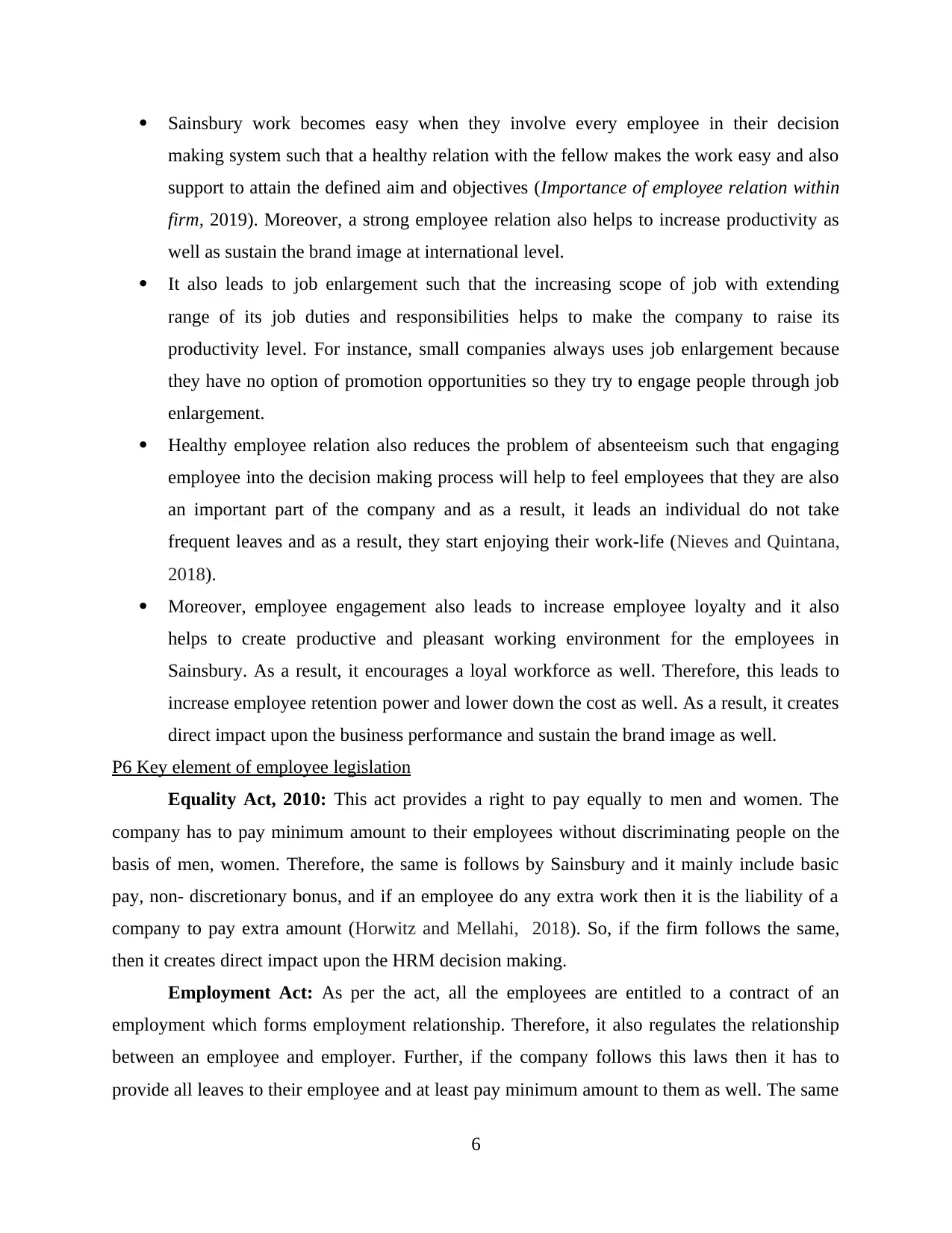
Sainsbury work becomes easy when they involve every employee in their decision
making system such that a healthy relation with the fellow makes the work easy and also
support to attain the defined aim and objectives (Importance of employee relation within
firm, 2019). Moreover, a strong employee relation also helps to increase productivity as
well as sustain the brand image at international level.
It also leads to job enlargement such that the increasing scope of job with extending
range of its job duties and responsibilities helps to make the company to raise its
productivity level. For instance, small companies always uses job enlargement because
they have no option of promotion opportunities so they try to engage people through job
enlargement.
Healthy employee relation also reduces the problem of absenteeism such that engaging
employee into the decision making process will help to feel employees that they are also
an important part of the company and as a result, it leads an individual do not take
frequent leaves and as a result, they start enjoying their work-life (Nieves and Quintana,
2018).
Moreover, employee engagement also leads to increase employee loyalty and it also
helps to create productive and pleasant working environment for the employees in
Sainsbury. As a result, it encourages a loyal workforce as well. Therefore, this leads to
increase employee retention power and lower down the cost as well. As a result, it creates
direct impact upon the business performance and sustain the brand image as well.
P6 Key element of employee legislation
Equality Act, 2010: This act provides a right to pay equally to men and women. The
company has to pay minimum amount to their employees without discriminating people on the
basis of men, women. Therefore, the same is follows by Sainsbury and it mainly include basic
pay, non- discretionary bonus, and if an employee do any extra work then it is the liability of a
company to pay extra amount (Horwitz and Mellahi, 2018). So, if the firm follows the same,
then it creates direct impact upon the HRM decision making.
Employment Act: As per the act, all the employees are entitled to a contract of an
employment which forms employment relationship. Therefore, it also regulates the relationship
between an employee and employer. Further, if the company follows this laws then it has to
provide all leaves to their employee and at least pay minimum amount to them as well. The same
6
making system such that a healthy relation with the fellow makes the work easy and also
support to attain the defined aim and objectives (Importance of employee relation within
firm, 2019). Moreover, a strong employee relation also helps to increase productivity as
well as sustain the brand image at international level.
It also leads to job enlargement such that the increasing scope of job with extending
range of its job duties and responsibilities helps to make the company to raise its
productivity level. For instance, small companies always uses job enlargement because
they have no option of promotion opportunities so they try to engage people through job
enlargement.
Healthy employee relation also reduces the problem of absenteeism such that engaging
employee into the decision making process will help to feel employees that they are also
an important part of the company and as a result, it leads an individual do not take
frequent leaves and as a result, they start enjoying their work-life (Nieves and Quintana,
2018).
Moreover, employee engagement also leads to increase employee loyalty and it also
helps to create productive and pleasant working environment for the employees in
Sainsbury. As a result, it encourages a loyal workforce as well. Therefore, this leads to
increase employee retention power and lower down the cost as well. As a result, it creates
direct impact upon the business performance and sustain the brand image as well.
P6 Key element of employee legislation
Equality Act, 2010: This act provides a right to pay equally to men and women. The
company has to pay minimum amount to their employees without discriminating people on the
basis of men, women. Therefore, the same is follows by Sainsbury and it mainly include basic
pay, non- discretionary bonus, and if an employee do any extra work then it is the liability of a
company to pay extra amount (Horwitz and Mellahi, 2018). So, if the firm follows the same,
then it creates direct impact upon the HRM decision making.
Employment Act: As per the act, all the employees are entitled to a contract of an
employment which forms employment relationship. Therefore, it also regulates the relationship
between an employee and employer. Further, if the company follows this laws then it has to
provide all leaves to their employee and at least pay minimum amount to them as well. The same
6
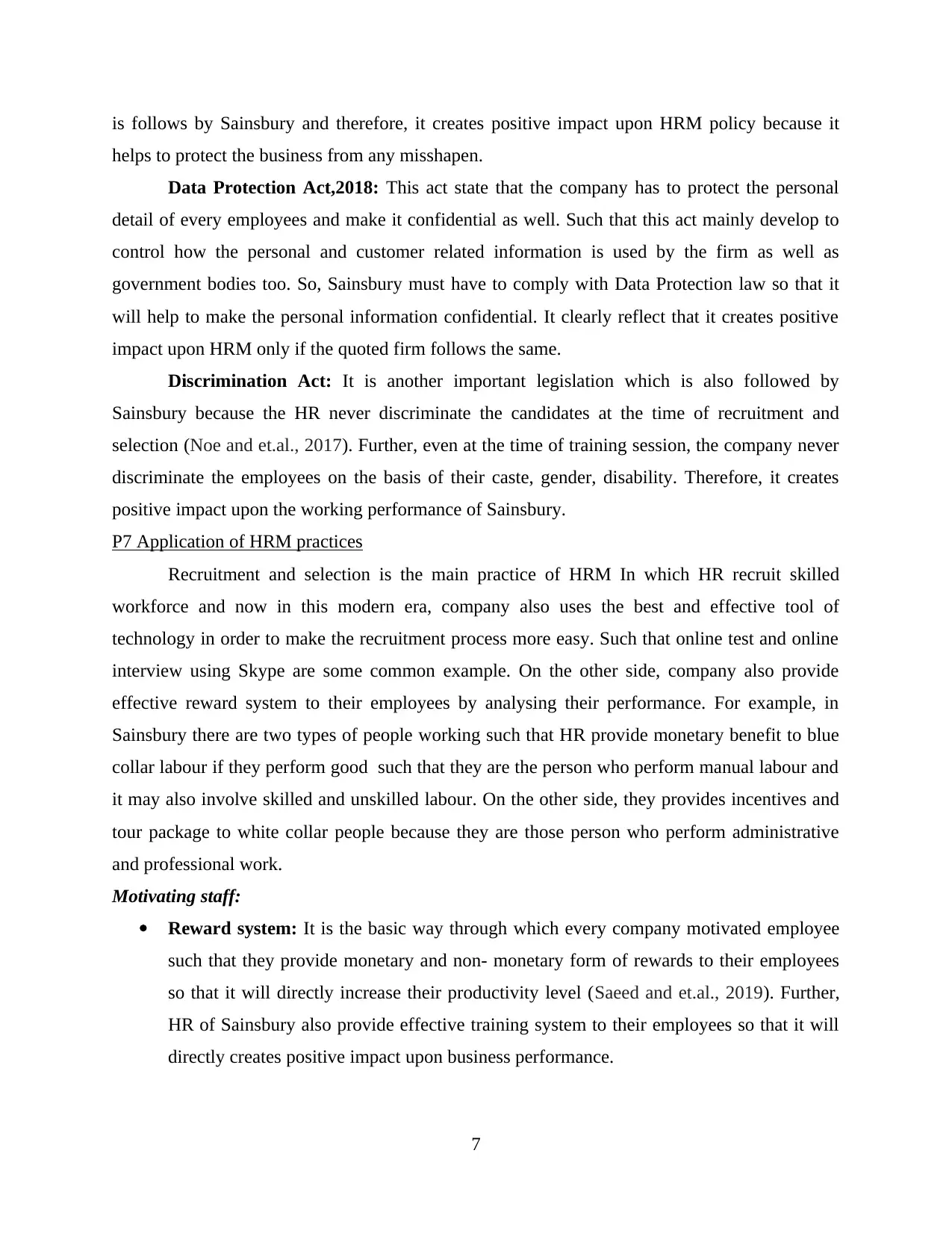
is follows by Sainsbury and therefore, it creates positive impact upon HRM policy because it
helps to protect the business from any misshapen.
Data Protection Act,2018: This act state that the company has to protect the personal
detail of every employees and make it confidential as well. Such that this act mainly develop to
control how the personal and customer related information is used by the firm as well as
government bodies too. So, Sainsbury must have to comply with Data Protection law so that it
will help to make the personal information confidential. It clearly reflect that it creates positive
impact upon HRM only if the quoted firm follows the same.
Discrimination Act: It is another important legislation which is also followed by
Sainsbury because the HR never discriminate the candidates at the time of recruitment and
selection (Noe and et.al., 2017). Further, even at the time of training session, the company never
discriminate the employees on the basis of their caste, gender, disability. Therefore, it creates
positive impact upon the working performance of Sainsbury.
P7 Application of HRM practices
Recruitment and selection is the main practice of HRM In which HR recruit skilled
workforce and now in this modern era, company also uses the best and effective tool of
technology in order to make the recruitment process more easy. Such that online test and online
interview using Skype are some common example. On the other side, company also provide
effective reward system to their employees by analysing their performance. For example, in
Sainsbury there are two types of people working such that HR provide monetary benefit to blue
collar labour if they perform good such that they are the person who perform manual labour and
it may also involve skilled and unskilled labour. On the other side, they provides incentives and
tour package to white collar people because they are those person who perform administrative
and professional work.
Motivating staff:
Reward system: It is the basic way through which every company motivated employee
such that they provide monetary and non- monetary form of rewards to their employees
so that it will directly increase their productivity level (Saeed and et.al., 2019). Further,
HR of Sainsbury also provide effective training system to their employees so that it will
directly creates positive impact upon business performance.
7
helps to protect the business from any misshapen.
Data Protection Act,2018: This act state that the company has to protect the personal
detail of every employees and make it confidential as well. Such that this act mainly develop to
control how the personal and customer related information is used by the firm as well as
government bodies too. So, Sainsbury must have to comply with Data Protection law so that it
will help to make the personal information confidential. It clearly reflect that it creates positive
impact upon HRM only if the quoted firm follows the same.
Discrimination Act: It is another important legislation which is also followed by
Sainsbury because the HR never discriminate the candidates at the time of recruitment and
selection (Noe and et.al., 2017). Further, even at the time of training session, the company never
discriminate the employees on the basis of their caste, gender, disability. Therefore, it creates
positive impact upon the working performance of Sainsbury.
P7 Application of HRM practices
Recruitment and selection is the main practice of HRM In which HR recruit skilled
workforce and now in this modern era, company also uses the best and effective tool of
technology in order to make the recruitment process more easy. Such that online test and online
interview using Skype are some common example. On the other side, company also provide
effective reward system to their employees by analysing their performance. For example, in
Sainsbury there are two types of people working such that HR provide monetary benefit to blue
collar labour if they perform good such that they are the person who perform manual labour and
it may also involve skilled and unskilled labour. On the other side, they provides incentives and
tour package to white collar people because they are those person who perform administrative
and professional work.
Motivating staff:
Reward system: It is the basic way through which every company motivated employee
such that they provide monetary and non- monetary form of rewards to their employees
so that it will directly increase their productivity level (Saeed and et.al., 2019). Further,
HR of Sainsbury also provide effective training system to their employees so that it will
directly creates positive impact upon business performance.
7
⊘ This is a preview!⊘
Do you want full access?
Subscribe today to unlock all pages.

Trusted by 1+ million students worldwide
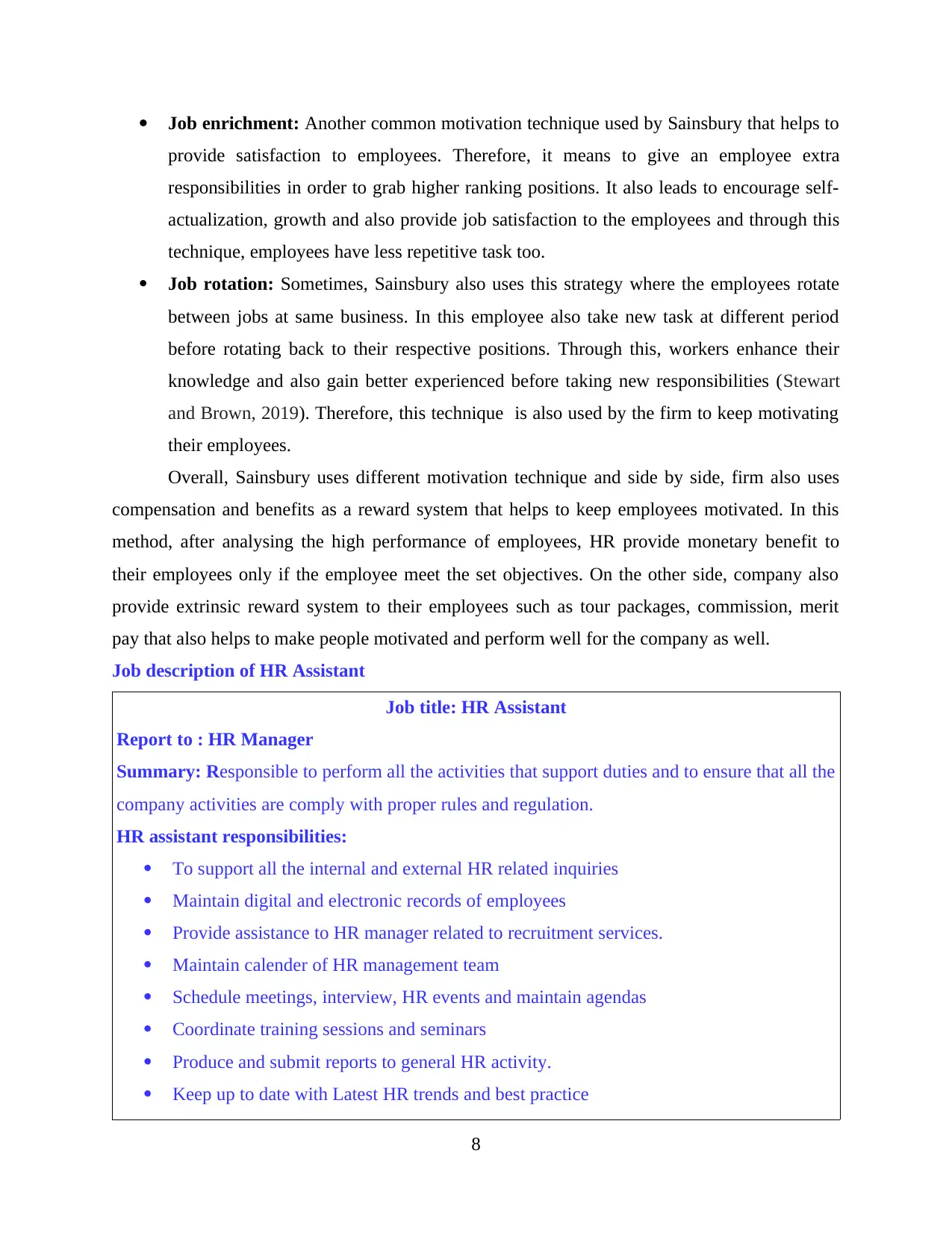
Job enrichment: Another common motivation technique used by Sainsbury that helps to
provide satisfaction to employees. Therefore, it means to give an employee extra
responsibilities in order to grab higher ranking positions. It also leads to encourage self-
actualization, growth and also provide job satisfaction to the employees and through this
technique, employees have less repetitive task too.
Job rotation: Sometimes, Sainsbury also uses this strategy where the employees rotate
between jobs at same business. In this employee also take new task at different period
before rotating back to their respective positions. Through this, workers enhance their
knowledge and also gain better experienced before taking new responsibilities (Stewart
and Brown, 2019). Therefore, this technique is also used by the firm to keep motivating
their employees.
Overall, Sainsbury uses different motivation technique and side by side, firm also uses
compensation and benefits as a reward system that helps to keep employees motivated. In this
method, after analysing the high performance of employees, HR provide monetary benefit to
their employees only if the employee meet the set objectives. On the other side, company also
provide extrinsic reward system to their employees such as tour packages, commission, merit
pay that also helps to make people motivated and perform well for the company as well.
Job description of HR Assistant
Job title: HR Assistant
Report to : HR Manager
Summary: Responsible to perform all the activities that support duties and to ensure that all the
company activities are comply with proper rules and regulation.
HR assistant responsibilities:
To support all the internal and external HR related inquiries
Maintain digital and electronic records of employees
Provide assistance to HR manager related to recruitment services.
Maintain calender of HR management team
Schedule meetings, interview, HR events and maintain agendas
Coordinate training sessions and seminars
Produce and submit reports to general HR activity.
Keep up to date with Latest HR trends and best practice
8
provide satisfaction to employees. Therefore, it means to give an employee extra
responsibilities in order to grab higher ranking positions. It also leads to encourage self-
actualization, growth and also provide job satisfaction to the employees and through this
technique, employees have less repetitive task too.
Job rotation: Sometimes, Sainsbury also uses this strategy where the employees rotate
between jobs at same business. In this employee also take new task at different period
before rotating back to their respective positions. Through this, workers enhance their
knowledge and also gain better experienced before taking new responsibilities (Stewart
and Brown, 2019). Therefore, this technique is also used by the firm to keep motivating
their employees.
Overall, Sainsbury uses different motivation technique and side by side, firm also uses
compensation and benefits as a reward system that helps to keep employees motivated. In this
method, after analysing the high performance of employees, HR provide monetary benefit to
their employees only if the employee meet the set objectives. On the other side, company also
provide extrinsic reward system to their employees such as tour packages, commission, merit
pay that also helps to make people motivated and perform well for the company as well.
Job description of HR Assistant
Job title: HR Assistant
Report to : HR Manager
Summary: Responsible to perform all the activities that support duties and to ensure that all the
company activities are comply with proper rules and regulation.
HR assistant responsibilities:
To support all the internal and external HR related inquiries
Maintain digital and electronic records of employees
Provide assistance to HR manager related to recruitment services.
Maintain calender of HR management team
Schedule meetings, interview, HR events and maintain agendas
Coordinate training sessions and seminars
Produce and submit reports to general HR activity.
Keep up to date with Latest HR trends and best practice
8
Paraphrase This Document
Need a fresh take? Get an instant paraphrase of this document with our AI Paraphraser
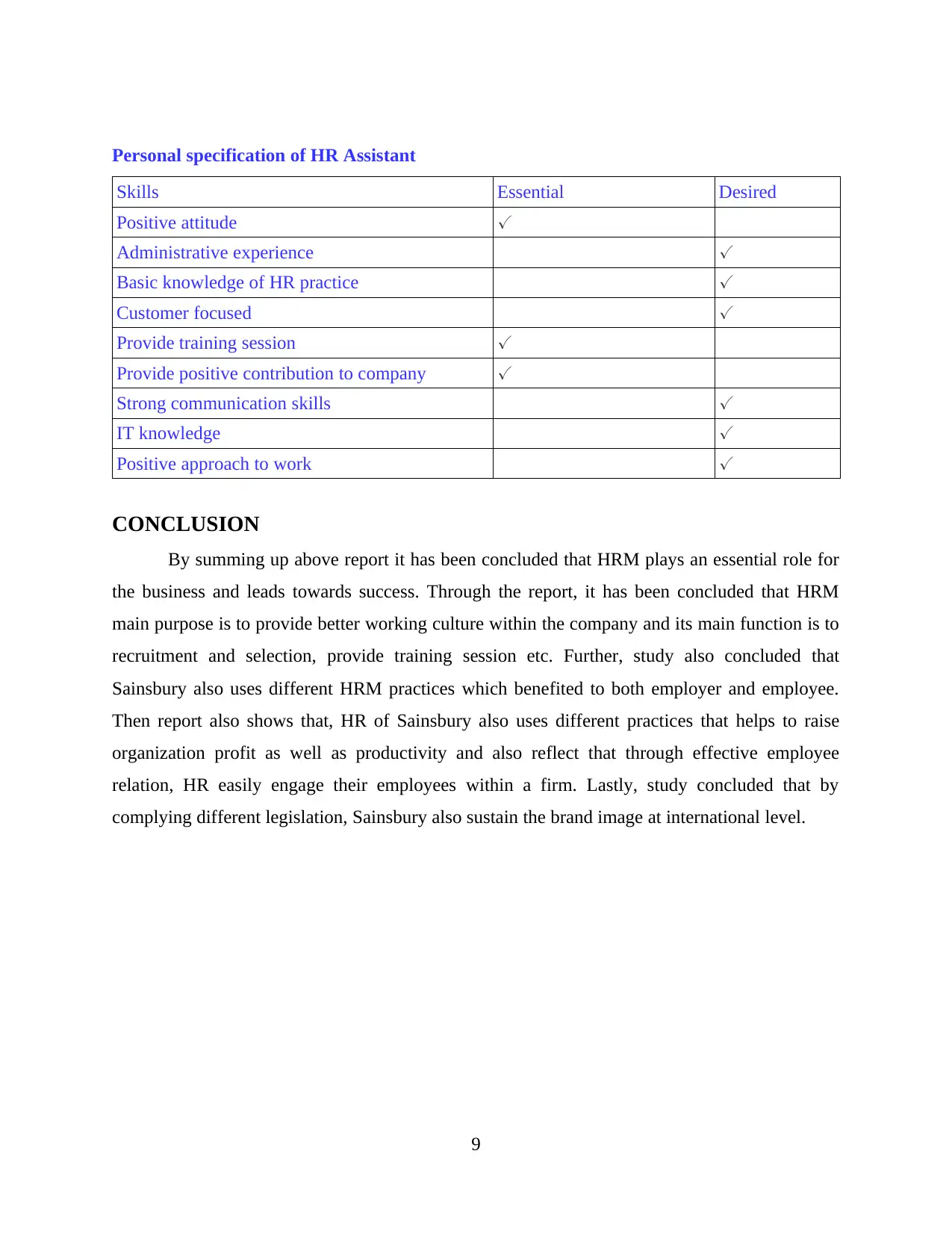
Personal specification of HR Assistant
Skills Essential Desired
Positive attitude ✓
Administrative experience ✓
Basic knowledge of HR practice ✓
Customer focused ✓
Provide training session ✓
Provide positive contribution to company ✓
Strong communication skills ✓
IT knowledge ✓
Positive approach to work ✓
CONCLUSION
By summing up above report it has been concluded that HRM plays an essential role for
the business and leads towards success. Through the report, it has been concluded that HRM
main purpose is to provide better working culture within the company and its main function is to
recruitment and selection, provide training session etc. Further, study also concluded that
Sainsbury also uses different HRM practices which benefited to both employer and employee.
Then report also shows that, HR of Sainsbury also uses different practices that helps to raise
organization profit as well as productivity and also reflect that through effective employee
relation, HR easily engage their employees within a firm. Lastly, study concluded that by
complying different legislation, Sainsbury also sustain the brand image at international level.
9
Skills Essential Desired
Positive attitude ✓
Administrative experience ✓
Basic knowledge of HR practice ✓
Customer focused ✓
Provide training session ✓
Provide positive contribution to company ✓
Strong communication skills ✓
IT knowledge ✓
Positive approach to work ✓
CONCLUSION
By summing up above report it has been concluded that HRM plays an essential role for
the business and leads towards success. Through the report, it has been concluded that HRM
main purpose is to provide better working culture within the company and its main function is to
recruitment and selection, provide training session etc. Further, study also concluded that
Sainsbury also uses different HRM practices which benefited to both employer and employee.
Then report also shows that, HR of Sainsbury also uses different practices that helps to raise
organization profit as well as productivity and also reflect that through effective employee
relation, HR easily engage their employees within a firm. Lastly, study concluded that by
complying different legislation, Sainsbury also sustain the brand image at international level.
9
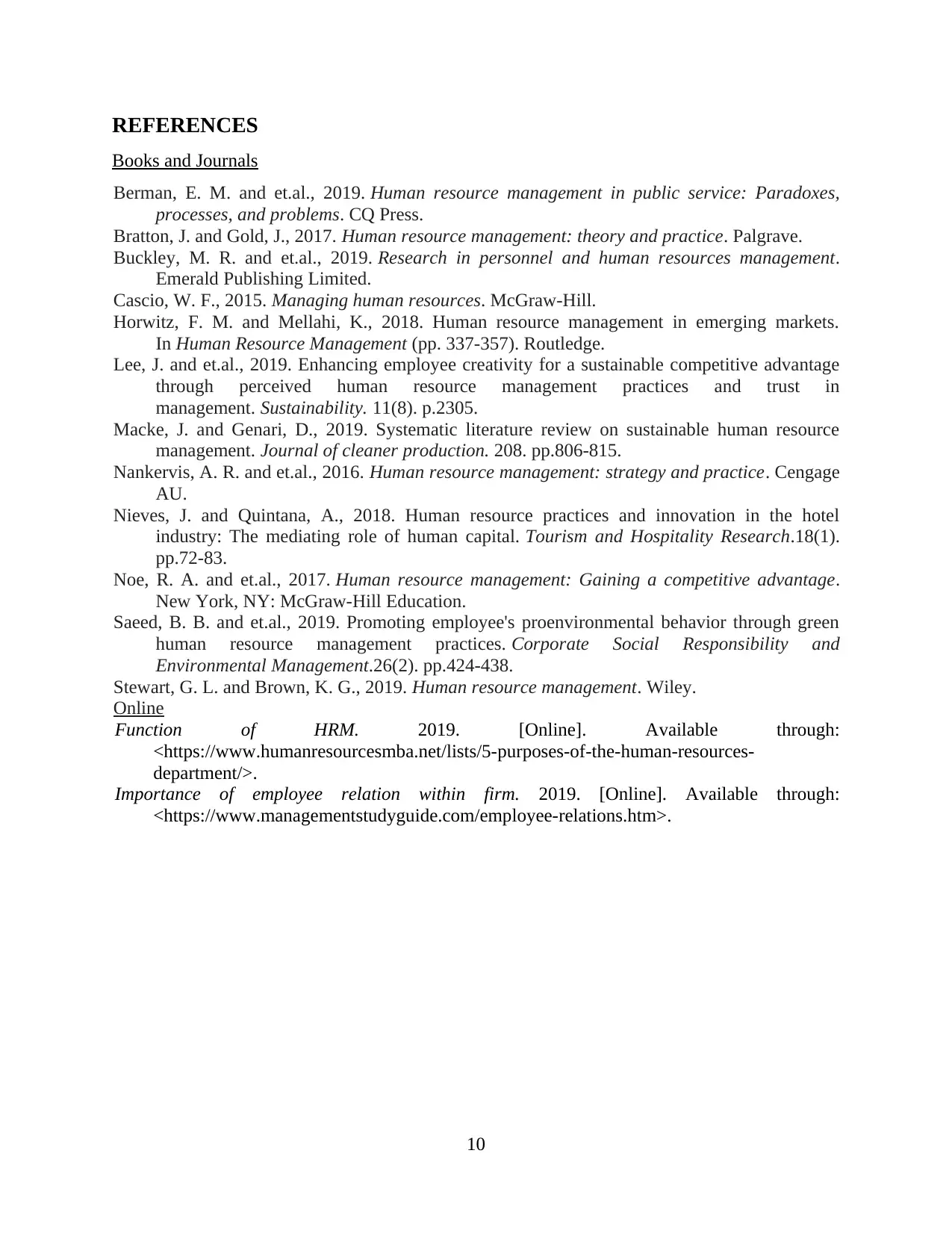
REFERENCES
Books and Journals
Berman, E. M. and et.al., 2019. Human resource management in public service: Paradoxes,
processes, and problems. CQ Press.
Bratton, J. and Gold, J., 2017. Human resource management: theory and practice. Palgrave.
Buckley, M. R. and et.al., 2019. Research in personnel and human resources management.
Emerald Publishing Limited.
Cascio, W. F., 2015. Managing human resources. McGraw-Hill.
Horwitz, F. M. and Mellahi, K., 2018. Human resource management in emerging markets.
In Human Resource Management (pp. 337-357). Routledge.
Lee, J. and et.al., 2019. Enhancing employee creativity for a sustainable competitive advantage
through perceived human resource management practices and trust in
management. Sustainability. 11(8). p.2305.
Macke, J. and Genari, D., 2019. Systematic literature review on sustainable human resource
management. Journal of cleaner production. 208. pp.806-815.
Nankervis, A. R. and et.al., 2016. Human resource management: strategy and practice. Cengage
AU.
Nieves, J. and Quintana, A., 2018. Human resource practices and innovation in the hotel
industry: The mediating role of human capital. Tourism and Hospitality Research.18(1).
pp.72-83.
Noe, R. A. and et.al., 2017. Human resource management: Gaining a competitive advantage.
New York, NY: McGraw-Hill Education.
Saeed, B. B. and et.al., 2019. Promoting employee's proenvironmental behavior through green
human resource management practices. Corporate Social Responsibility and
Environmental Management.26(2). pp.424-438.
Stewart, G. L. and Brown, K. G., 2019. Human resource management. Wiley.
Online
Function of HRM. 2019. [Online]. Available through:
<https://www.humanresourcesmba.net/lists/5-purposes-of-the-human-resources-
department/>.
Importance of employee relation within firm. 2019. [Online]. Available through:
<https://www.managementstudyguide.com/employee-relations.htm>.
10
Books and Journals
Berman, E. M. and et.al., 2019. Human resource management in public service: Paradoxes,
processes, and problems. CQ Press.
Bratton, J. and Gold, J., 2017. Human resource management: theory and practice. Palgrave.
Buckley, M. R. and et.al., 2019. Research in personnel and human resources management.
Emerald Publishing Limited.
Cascio, W. F., 2015. Managing human resources. McGraw-Hill.
Horwitz, F. M. and Mellahi, K., 2018. Human resource management in emerging markets.
In Human Resource Management (pp. 337-357). Routledge.
Lee, J. and et.al., 2019. Enhancing employee creativity for a sustainable competitive advantage
through perceived human resource management practices and trust in
management. Sustainability. 11(8). p.2305.
Macke, J. and Genari, D., 2019. Systematic literature review on sustainable human resource
management. Journal of cleaner production. 208. pp.806-815.
Nankervis, A. R. and et.al., 2016. Human resource management: strategy and practice. Cengage
AU.
Nieves, J. and Quintana, A., 2018. Human resource practices and innovation in the hotel
industry: The mediating role of human capital. Tourism and Hospitality Research.18(1).
pp.72-83.
Noe, R. A. and et.al., 2017. Human resource management: Gaining a competitive advantage.
New York, NY: McGraw-Hill Education.
Saeed, B. B. and et.al., 2019. Promoting employee's proenvironmental behavior through green
human resource management practices. Corporate Social Responsibility and
Environmental Management.26(2). pp.424-438.
Stewart, G. L. and Brown, K. G., 2019. Human resource management. Wiley.
Online
Function of HRM. 2019. [Online]. Available through:
<https://www.humanresourcesmba.net/lists/5-purposes-of-the-human-resources-
department/>.
Importance of employee relation within firm. 2019. [Online]. Available through:
<https://www.managementstudyguide.com/employee-relations.htm>.
10
⊘ This is a preview!⊘
Do you want full access?
Subscribe today to unlock all pages.

Trusted by 1+ million students worldwide
1 out of 12
Related Documents
Your All-in-One AI-Powered Toolkit for Academic Success.
+13062052269
info@desklib.com
Available 24*7 on WhatsApp / Email
![[object Object]](/_next/static/media/star-bottom.7253800d.svg)
Unlock your academic potential
Copyright © 2020–2025 A2Z Services. All Rights Reserved. Developed and managed by ZUCOL.





